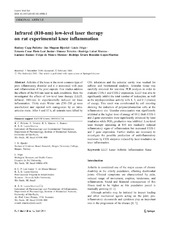Infrared (810-nm) low-level laser therapy on rat experimental knee inflammation
Pallotta, Rodney Capp; Bjordal, Jan Magnus; Frigo, Lúcio; Leal Junior, Ernesto Cesar Pinto; Teixeira, Simone; Marcos, Rodrigo Labat; Ramos, Luciano; Messias, Felipe de Moura; Lopes-Martins, Rodrigo Álvaro Brandão
Peer reviewed, Journal article
Published version

View/
Date
2011-04-12Metadata
Show full item recordCollections
Original version
https://doi.org/10.1007/s10103-011-0906-1Abstract
Arthritis of the knee is the most common type of joint inflammatory disorder and it is associated with pain and inflammation of the joint capsule. Few studies address the effects of the 810-nm laser in such conditions. Here we investigated the effects of low-level laser therapy (LLLT; infrared, 810-nm) in experimentally induced rat knee inflammation. Thirty male Wistar rats (230–250 g) were anesthetized and injected with carrageenan by an intraarticular route. After 6 and 12 h, all animals were killed by CO2 inhalation and the articular cavity was washed for cellular and biochemical analysis. Articular tissue was carefully removed for real-time PCR analysis in order to evaluate COX-1 and COX-2 expression. LLLT was able to significantly inhibit the total number of leukocytes, as well as the myeloperoxidase activity with 1, 3, and 6 J (Joules) of energy. This result was corroborated by cell counting showing the reduction of polymorphonuclear cells at the inflammatory site. Vascular extravasation was significantly inhibited at the higher dose of energy of 10 J. Both COX-1 and 2 gene expression were significantly enhanced by laser irradiation while PGE2 production was inhibited. Low-level laser therapy operating at 810 nm markedly reduced inflammatory signs of inflammation but increased COX-1 and 2 gene expression. Further studies are necessary to investigate the possible production of antiinflammatory mediators by COX enzymes induced by laser irradiation in knee inflammation.
